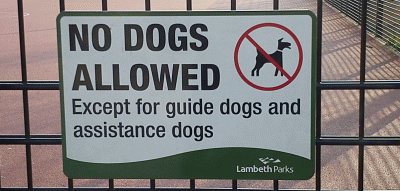Islington vet, Caroline Allen, writes on the changing face of dogs in London.
 I’ve been a vet now for 13 years, 10 of which have been spent in London. Mostly it’s a job I love, but it can be deeply frustrating having to pick up the pieces of some of society’s problems that manifest themselves in our pets.
I’ve been a vet now for 13 years, 10 of which have been spent in London. Mostly it’s a job I love, but it can be deeply frustrating having to pick up the pieces of some of society’s problems that manifest themselves in our pets.
Stitching a dog back together after it has been attacked or involved in a fight. Or treating a poor sickly pup; purchased either online or from a pet shop, which is suffering from perfectly preventable diseases because it’s come from a puppy farm.
Or removing 25 teeth from just 2 dogs in one day last week; mostly because the way they had been bred meant the teeth didn’t really fit into their mouths properly.
Vets can feel quite helpless when it comes to making a real difference. This may be one of the reasons why the suicide rate of vets is four times the national average and double that of dentists/doctors, not a happy figure. Many good vets do try to educate people, but we tend to see the problems when it is too late.
Dangerous dogs
The issue of dangerous dogs is one that remains high on the agenda with dogs attacking people with frightening frequency. In London alone 450 people were treated in hospital for dog bites in a 10 month period in 2010-2011.
The frequency of other dogs being attacked is also very high with us treating a dog attack almost weekly.Unfortunately things don’t seem to be getting any better; my experience suggests things are worse than ever.
The Dangerous Dogs Act must surely be one of the most ill thought-out and most damaging laws ever to get passed. Working in East London 10 year ago I knew one Pitbull, he was a sweetie, with responsible owners; muzzled, microchipped and neutered he lived to a good old age as a much loved family pet.
Now we get people bringing in ‘Pitbull’ type dogs to the practice all the time, they are a status symbol for a small, but not insignificant, group of, mainly young, men. They are often poorly trained and can be used for fighting and as protection. And now ‘Staf’ type dog, or a Staffordshire Bull Terrier to give them their full name, are often assumed to be aggressive or dangerous.
In fact, in my experience, most Stafs are sensitive, loving and affectionate, they love a cuddle. We have many wonderful owners with perfectly behaved Stafs, they complain though of people’s prejudice about their dogs. Of course any animal can become aggressive with maltreatment and abuse. Irresponsible breeding and lack of training is leaving many of these dogs abandoned. With shelters full and a lack of homes thousands are killed every year.
Sadly Stafs are the victims of an image problem, one that I believe really began with the breed based legislation and perpetuated by the media and irresponsible breeding.
We need new legislation

It is time for legislation that deals with the irresponsible owners and especially breeders, not that criminalises particular breeds.
At the other extreme we have the dogs with a rather different image. In the world of celebrity and advertising it is the ‘handbag dogs’ who grace the pages of magazines.
Breeds such as Chihuahuas, Pugs and French Bulldogs are definitely trendy at the moment and I see many, many more of these dogs than I did just five years ago. Recently it was reported that more ‘traditional’ breeds are dying out, while these breeds become more popular.
It is very rare to see aggression in these breeds; in my experience they are cute with great personalities. They are usually much loved and pampered. Unfortunately the domed forehead that gives them the cute bug-eyed look is a serious design flaw. A short palate and nose leads to breathing problems and crowded teeth, leading to dental disease.
The bug eyes are prone to drying out and ulcers. Birth can be a problem, with an increased complications and a need for caesarean section. With much money to be made irresponsible breeding also rears its ugly head, with puppy farms churning out these pups in terrible conditions, with an increase in infectious and congenital disease. Legislation is surely required here to regulate breeder, force them to deal with abnormal anatomy and ensure that the origin of a pup can be traced.
So we have one population of dogs in London suffering because of a negative image, being often unfairly victimised as aggressive and dangerous and far too often ending up on the scrapheap, no longer wanted by society.
At the same time another population seems to be riding high on a wave of celebrity endorsement; popular and in demand. Unfortunately it seems that the costs of this image can also be a very high one.
I’m sure there are some interest parallels we could draw here….



0 Comments
You can be the first one to leave a comment.